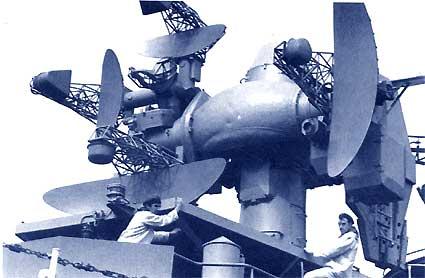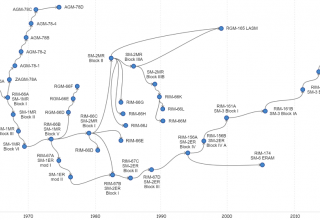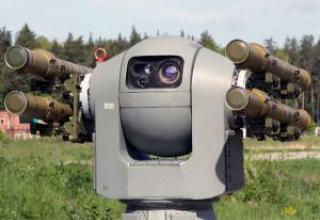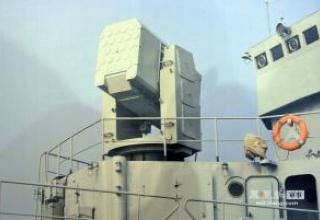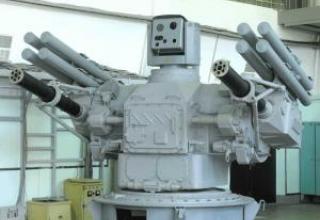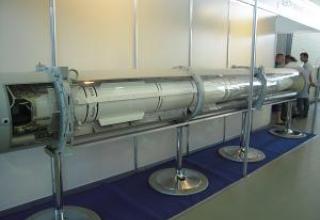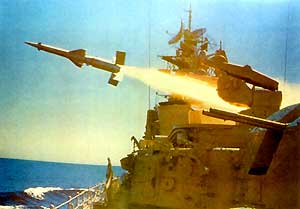
The development of the first domestic universal missile system M-1 for ships of projects 61 and 63 was started by Resolution of the USSR Council of Ministers №1149-592 of 17.08.1956. But already by Resolution № 1190-610 of 25 August the same year it was decided to put the M-1 on ships of projects 58 and 62. The M-1 ship's universal complex was unified with the C-125 ground SAM system by many elements. Thus, both systems had identical missiles (B-600, B-601, etc.).
The Chief Designer of the "Wave" was I.A.Ignatiev (VNII "Altair" - MSP), and the Chief Designer of the V-600 missile was P.D.Grushin (ICBM "Fakel" - MAP). By CM Resolution No. 889-382 of 24.08.62, the M-1 complex with the B-600 missile was adopted for service with the Navy. Later, the M-1 complex was named "Wave" and the B-600 missile - unclassified index 4K90.
To defeat targets flying at altitudes above 10 km, the CM Resolution № 561-233 of 21.06.61 began work on the B-601 missile for the land complex C-125. After a series of tests, the B-601 (4K91) missile was adopted for service with the ground forces in 1964. In the same year it was decided to equip with this missile and the M-1 complex. The first 7 ships received B-601 during 1967.
During the intra-complex modernization of air defense systems, the main improvements concerned the control equipment and the anti-aircraft missiles themselves. Air defense systems with missiles B-601 was called "Wave-M", with missiles B-611 - "Wave-11", with missiles B-601M - "Wave-N", with enhanced noise immunity - "Wave-P". The "Wave-P" complex was adopted in 1976. Its noise-immune protection was ensured by increasing the noise-immune protection of the missile control radio channels and introducing an optoelectronic target tracking channel (TV 9SHZ) into the control system. In the 1980s, the "Wave" complex became known as a strike system (UZRK) and allowed to fire missiles at surface targets.
Later, when the problem of protecting ships from low-flying ICBMs was raised, another modernization of the complex ("Wave-N") was carried out using a missile B-601M, which provides target engagement at an altitude of 3-5 meters above the wave crest.
Despite some shortcomings, the M-1 system proved to be generally successful and was widely used by the Russian Navy, and is still in service.
Composition:
The launchers were placed on the roof of the superstructure in the bow (region 52.5) and in the stern (region 204.5). The ZIF-101 (see projections) was a paired, open, stabilized bollard type launcher with bottom suspension of two missiles on two guide beams. Cellars of missile ammunition (No. 4 - bow, No. 8 - stern) with drum storage system of missiles had two vertical drums for eight anti-aircraft guided missiles (SAM) each. On the charging line, the missile was fed by turning the drum at an angle of 45 °, and mechanical charging was carried out by a chain pusher. Electric power drive (ESP-101) and remote control provided the functioning of the launcher. The standard equipment of the missile cellar - 15 combat and 1 training missile. Serial production of PU ZIF-101 was set up at the plant "Barrikady" in Volgograd.
Following the PU ZIF-101, a tandem unit ZIF-102 was created. The principal difference of the new PU was the feeding of rockets of conveyor type instead of drum type. As a result the ammunition of one PU has increased from 16 to 32 missiles.
In total, the M-1 complex with ZIF-101 PU was armed with 20 ships pr.61, 61 M and 61 MP (one for Poland); 4 ships pr.58; one pr.56K; 8 pr.56A; and 5 ships pr.61ME (built for India). The M-1 complex with ZIF-102 PU received 4 ships of Ave. The M-1 complex with PU Mill-102 received 4 ships of 1134 Ave., 3 ships of 56U project, and 8 ships of 57A project.
B-600 and its later variants are two-stage rockets with powder engines made according to the aerodynamic scheme "duck". The first stage is equipped with four post-launch stabilizers and a powder jet engine (PRD-36). PRD-36 is equipped with 14 single-channel cylindrical powder draughts (made of NMF-ZK powder) with total weight of 280 kg. The engine of the second stage is equipped with one draughtsman weighing 125 kg, powder brand NM-4Sh. The 4G-90 shrapnel-flag warhead is equipped with ready-made attack elements. The total weight of the combat unit is 60 kg, of which 32-33 kg is the weight of TNT alloy with hexogen. The "Strait" (5E15) radio detonator operates at misses of up to 58 m. Combat unit 4G-90 gives 3560-3570 pieces with an average weight of about 5.4 gr. Response time of the self-destructor is 26 sec.
The B-601 missile differed from the B-600 only by its marching engine design and had a new combat unit. The marching engine had a new 150 kg draughtsman made of "301" powder. The new combat unit 5B18 was designed by NII-6. On tests it gave about 4500 pieces weighing 4.72 - 4.79 kg. The new combat unit provided target engagement with a probability of 0.75 - 0.90 on a miss of 20 m and probability of 0.6 on a miss of 25-47 m. To install the B-601 missile on the ZIF-101 PU it was necessary to improve the missile's marching mount. Besides, the Yatagan control system underwent some modernization.
At rocket launch the first (launch) stage works within 5 s, developing a thrust of 30 t, and the second (marching) - about 22 s, developing a thrust of 3 t.
The missile guidance method is optimal straightening and covering of the target. When shooting at low-flying targets, the method of pointing "Horka" is added to this.
The Yatagan firing control system was developed at the Research Institute of 10 GKRE, and the equipment for the antenna post drives was developed at the Central Research Institute of 173. The Yatagan system is a set of instruments and devices providing reception and target designation from the ship's radar detection station, target and missile tracking on the trajectory, prelaunch preparation and launch of missiles, development of control commands to point missiles at the target. The missile was guided by the radar until the radar detonator was triggered. The disadvantage of this radio command system is its single-channel accuracy, as well as a sharp decrease in accuracy of firing with increasing distance to the target (see the area of engagement of the Wave SAM system with B-600).
Each antenna post of the Yatagan system had five antennas. Two small antennas provided so-called "rough" guidance to the target, one antenna acted as a radio transmitter for operator commands, and two large antennas accompanied the target and more accurately guided the missile. Until one target was hit, it was impossible to fight a second, third, etc. target.
Characteristics:
| Rocket | "В-600" | "В-601" |
| Length, m | 5885 | 5948 |
| Diameter of the first stage, m | - | 552 |
| Diameter of the second stage, m | - | 379 |
| Start weight,kg | 923 | 980 |
| Weight BC,kg | 60 | 72 |
| Flight Speed, m/sec. | 600 | 730 |
| Maximum firing height, km | 10 | 14 |
| Minimum firing height, m. | 100 | 100 |
| Maximum inclined range, km | 15 | 22 |
| Minimum inclined range, km | 4 | 4 |
| Target speed maximum,m/sec | 600 | 700 |
| Starting machine Mill-101 | |
| Speed of fire | 1 salvo in 50s |
| Horizontal pointing angle (HN), degree | 330 |
| Vertical pointing angle (VN), degree | -10, +95 |
| GN speed, deg/s. | 40 |
| Speed VH, deg / s | 30 |
| Charging pleasure, degree. | 90 |
| Distance between the PU axes, mm | 3500 |
| Track length of the ZUR rope along the rails at start, mm | 1000 |
| Height of flame line at 0°, mm | 2300 |
| Dimensions | |
| -Height at 0° without stabilizing, mm | 3380 |
| -Height at 0° angle, taking into account stabilization, mm | 4060 |
| -High at 83° without stabilization, mm | 4760 |
| -Height at 83° with stabilization, mm | 5390 |
| -Sweeping radius at the front without RSD, mm | 3800 |
| -Sweeping radius at the front with ZSD, mm | 5670 |
| -Back sweeping radius without RSD, mm | 2050 |
| -Back sweeping radius with ZSD, mm | 2820 |
| - Distance from the PU axis of rotation to the charging line, mm | 1300 |
| Serve | |
| - drum speed, deg/s | 6 |
| - vertical feed path ZUR, mm | 8010 |
| - RMS feed speed, m/sec | 1,4 |
| Dimensions of cellars | |
| - length, mm | 10500 |
| - width, mm | 5200 |
| - height, mm | 7000 |
Testing:
Terms of development of the M-1 complex were ahead of the terms of delivery of the head ship at Prospect 61 of Plant № 1701 (SKR-25 from 9.10.62 "Komsomolets of Ukraine") - so the Order of the USSR CM № 2110 of 30.07.1959. joint tests of M-1 were transferred to the rocket ship "Bravy" pr.56K. Tests on "Bravo" were held in two stages - from 5.01.62 to 12.03.62 and from 12.03.62 to 30.04.62. During the tests it was noted that the time of "Yatagan" exit from the cold position was 5 minutes, the range of "Yatagan" escorting the target was 42 km with a 50% probability of capture and 36 km with a probability of 80%. The missile's range was 15 km, and the self-destruct time was 26 seconds.
During the tests of the complex was shot down six target aircraft MiG-15M, flying at an altitude of 0.6 to 10 km, with missiles missed from 9 to 48 meters. According to the commission, the probability of hitting the aircraft at a miss of 20 meters is 0.9, while at a miss of 40 meters - 0.4-0.6. The M-1 complex could hit targets flying at a speed of up to 600 meters per second. The target can maneuver at altitudes up to 4 km with an overload of 3 - 4 g, and at high altitudes - up to 2 - 3 g. The speed of the ship during launches can be up to 36 knots. There was no firing from Bravoi on surface targets.
According to the results of tests on "Bravoi" the M-1 SAM system was recommended for adoption for service.
Sources:
- Вестник ПВО
- Широкорад А. "Ракеты над морем", журнал "Техника и Оружие" №5, 1996
- Петров А. М., Асеев Д. А., Васильев Е. М. и др. "Оружие российского флота 1696-1996 гг." СПб: Судостроение
- А.В. Карпенко "Российское ракетное оружие 1943-1993". Санкт-Петербург, "ПИКА", 1993

